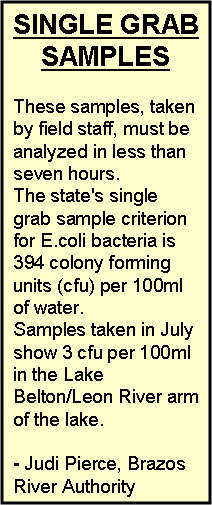Leon River ‘impaired’ upstream
August 2008
By Victoria Marie S. Bongat – Published August 17, 2008
TELEGRAM STAFF WRITER
AND Tammy Leytham
TELEGRAM METRO EDITOR
Boaters, swimmers and anglers have enjoyed the waters of Lake Belton during the summer, but the Leon River continues its flow south of the Belton Dam with little activity.
Travel that portion of the meandering river that flows through Belton and you’ll see a few rotting trot lines hanging from low tree limbs. Little else – save an occasional turtle – stirs the water.
The upper portion of the river near Hamilton and Lake Proctor has been designated “impaired” due to the level of bacteria found during water quality monitoring.
However, the river south of Belton Dam has good water quality, based on results of water samples taken by the Brazos River Authority in July.
Those samples show “concentrations (of fecal coliform or other bacteria) at all locations were well below the state’s water quality criterion for single grab samples,” Jay Bragg of the Authority said in an e-mail.
Bragg said the testing result “indicates good water quality at the time they were taken.”
This includes the area where the Temple Waste Water Treatment plant is located, though swimming and boating are prohibited at that site.
Most of the land along the river is privately owned and decks dot the banks along the route. Miller Springs Park and Heritage Park are located along the river, but public access is limited.
Still, if you catch a fish in the portion of the river south of the Belton Dam, it should be safe to eat, as long as the fish are cleaned, cooked and prepared properly, Bragg said.

For swimmers, there are always some risks associated with swimming in lakes and streams, Bragg said. “However, there are certainly elevated risks associated with swimming in the portion of the river listed as `impaired,”’ which is the upper portion above Belton Lake.
“The lower sections, however, have been determined to contain a sufficient flow for recreational use almost any time,” according to Tim Dybala, USDA-Natural Resources Conservation Service, Water Resources Assessment Team.
According to Dybala, water quality in Lake Belton is excellent based on the testing done by the Brazos River Authority.
There are reasons to be cautious.
“In recent years, authority data indicates a slight increase trend in nutrient concentrations, specifically nitrate plus nitrate nitrogen,” he wrote in an e-mail.
Suspected sources of the increased nutrient loadings are related to increased development activities around the lake such as lawn fertilizers and increased use of septic systems, Dybala said.
Nolan Creek also had “bacteria impairment,” according to data collected by the Authority. Nolan Creek flows through Belton, Killeen, Harker Heights and Fort Hood.
“Population growth is expanding rapidly in this region, resulting in roughly 600 new permits for on-site wastewater systems in the area each year,” Dybala wrote. “High levels of bacteria, E. coli, have been found in Nolan Creek, as well as a growing concern for nutrients.”
Municipal discharges, stormwater runoff, poorly functioning on-site sewage systems, and agriculture and livestock waste are also potential sources for nutrient and bacteria issues, he wrote.
Upper portion
The high levels of bacteria that have impaired the upper portion of the Leon River do not impact Lake Belton, said Dickie Clary, a Hamilton County commissioner.
“Bacteria is a live organism. It dies within a certain amount of days. Any bacteria that originate here is dead long before it gets to the lake,” he said.
It’s important to note, he said, that 41 percent of the bacteria in the upper portion of the river comes from nature – primarily wildlife – while 18 percent is human and 14 percent is from cattle.
There’s a combined effort under way to protect all the bodies of water. “The folks I’ve visited with in and around the Belton Lake area understand that we share this resource,” he said.
The Texas State Soil and Water Conservation Board is working with the Texas Commission on Environmental Quality and the Brazos River Authority in developing a Leon River Watershed Protection Plan, with local stakeholders taking an active role in developing land management strategies to reduce bacteria levels.
A Watershed Protection Plan is a coordinated framework for implementing strategies that holistically protect and restore the quality of water resources, said Pamela Casebolt of the Soil and Water Conservation Board.
“We’re still working with small focus groups in order to understand the concerns of area residents and to develop preliminary strategies that seem to be feasible for the Leon River watershed,” she said. “We intend to expand the public participation process as we ask citizens and municipalities to make decisions on how they will protect and restore their water resources.”
That effort deals mainly with the upper portion of the river that flows through Hamilton, Comanche and Coryell counties.
Clary sees progress in bringing together landowners, dairy farmers and officials at the state and local levels to determine “how we can go about improving the water.
“It makes sense to me to bring these people who will have to make the changes to the table – they are given the opportunity voluntarily to put measures in place,” he said.
Once the plan is completed and implemented, Clary believes there will be a positive outcome.
“I’m highly optimistic that the process will have a significant impact with a minimal cost,” he said.
Because of the cooperation between all the communities within the watershed, and with an approved management plan, he said there would be a chance to see measurable improvement in water quality within three to five years.
–Reprinted with permission of the Temple Daily Telegram

